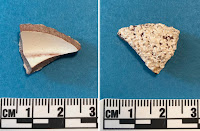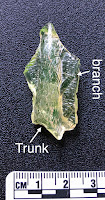CCASM volunteered to process artifacts recovered from Shovel Test Pits (STPs)
excavated as part of an ASM-sponsored project at Dielman Inn in New
Windsor. The lab was at Burch House on Mondays in
lieu of the regular Monday Charles County Lab.
Here is more about what we did as well as some of the artifacts that we processed.
Next week we will return to processing Charles County artifacts
On Monday February 7 Linda, Denise, and Carol were able to return to Burch House to continue cataloging the remaining Dielman Inn artifacts. All that needed to be done was to catalog the 24 remaining artifact bags at Burch House. It didn't take that long to remember what to do, and we were able to catalog half of the remaining bags. So we are almost finished. Unfortunately none of the artifacts merited being an artifact of the day. Maybe next week.
 |
| White-slipped Stoneware |
Closed during January due to Charles County Covid Restrictions
Monday December 13 Elsie, Linda, Mary, Peggy, and Carol finished sorting, measuring, tagging, and bagging all the 85 bags of Dielman Inn artifacts that were are Burch House!!! And we also found a unique artifact for the day! It is from an eighteenth century white-slipped stoneware vessel with a bread crumb pattern on the exterior. It is possibly part of a stoneware bear jug. A bear jug has the shape of a bear sitting up and has a removable bear head as the lid. The bread crumbs represent the fur.
Monday December 6 Claudia and Peggy finished washing the 85 bags of Dielman Inn artifacts that were are Burch House!!! Just in time since Elsie, Linda, Denise, and Carol also finished cataloging the 35 sorted bags (except half of one large bag). So next week we start sorting the remaining artifacts that are in Burch House.
Another 39 bags were washed at UMBC and will be processed there. Also Esther will catalog those plus an additional 27 bags. Since she is writing the report, she will be looking at all the artifacts at some time.
Once again we didn't come up with an artifact of the day.
 |
| Screen with mostly building material |
Wednesday is not a normal lab day, but the holidays are coming, and there will be fewer lab days. So Wednesday November 17 Linda, Mary, Peggy, Elsie, and Carol cataloged artifacts at Burch. This gave us a chance to choose an artifact of the day --one that we had seen Monday but had not photographed. We chose this clear glass fragment that appears to have an embossed tree on it as the artifact of the day. The pattern on the trunk of the tree looks like bark. There is a different pattern on the "background" but none on the small branches. Interesting.
Monday November 15 was too cold to be outside. So we spread out inside Burch House. A new volunteer Pat joined Linda, Elsie, Denise, Mary, Peggy, Claudia, Carole, and Carol. Claudia washed. Peggy, Mary, Denise, and Pat sorted, measured, and bagged. Linda, Elsie, Carole, and Carole cataloged. (We finally were able to start cataloging using two laptops.) A lot was going on, and we forgot to choose an artifact of the day.
 |
| Washing |
 |
| Sorting, Counting, Measuring, and Bagging |
 |
| Cataloging |
 |
| Decorative iron valence |
We chose this large piece of decorative iron valance as the artifact of the day.
Esther arrived with the remainder of the artifacts from Dielman Inn. The final STPs were dug this past weekend. In all there are 124 bags. So far we have washed artifacts from 56 bags and sorted the artifacts in 43 of those bags. Only two bags have gone all the way through the process with the artifacts being cataloged.
 |
| "DIELMAN" glass fragment |
Most of Monday November 1 was spent washing artifacts. Even though it was a chili day most of us decided to wash outdoors on the picnic tables. Linda, Elsie, and Mary were joined outside by three new volunteers. Claudia helped for the entire day while Chris and Mary (another Mary) helped for a couple of hours just to see what we did. Indoors Denise and Peggy washed while Carol sorted. Later Peggy, Denise, and Linda assisted with the sorting effort. In all we washed enough artifacts to fill six screens and sorted two screens of artifacts that had been washed last week.
We found this interesting clear glass fragment and chose it as the artifact of the day. The letters "DIELMAN" along with some decorations are embossed on the glass. Interesting since this excavations are at the Dielman Inn.
 |
| Washing Outdoors |
 |
| More Washing Outdoors |
 |
| Washing Indoors |
 |
| Creamware with interesting design |
Monday October 25 was another of those crisp days. Carole joined Denise, Mary, Linda, Elsie, Peggy, and Carol to work outside on the picnic tables. We spent most of the day sorting and bagging the remaining seventeen bags of artifacts recovered from the first day of digging STPs. This freed up the drying screens to be used when washing the 61 bags of artifacts recovered from STPs dug this past weekend that Esther brought around noon. In the afternoon while the rest of us continued to sort, measure, and bag, Elsie and later Linda started washing artifacts from this new batch of bags.
Since it is getting close to Halloween, we chose this printed creamware sherd as the artifact of the day. The pattern made some of us think of spider webs, skeletons, and other scary things.
 |
| Sorting |
 |
| Adding bag tag with count and measurement |
 |
| Washing artifact bag from next batch |
 |
| Glass sherd with Fish Scale Pattern |
Monday October 18 was one of those crisp days. Denise and Mary decided to stay outside and finish washing the two remaining bags of artifacts while Elsie, Peggy, Linda, and Carol stayed indoors and started sorting measuring, and bagging the now dry artifacts that had been washed the previous week. In the afternoon Mary joined those sorting while Elise and Denise left to help Esther Reed put poles in the ground at Rich Hill. With the reduced work force we were only able to process nine of the 26 bags, but the artifacts from one of those bags covered an entire screen. In the time it took us to process that one bag, we were able to process eight other bags. So not bad. By the way, a bag contains artifacts recovered from one level of an STP.
Among all the brick, coal, schist, and miscellaneous other artifacts we found this glass sherd with a fish scale pattern. and we chose it as the artifact of the day.
 |
| Sorting, Measuring, and Bagging Artifacts |
 |
| Ceramic Sherd |
 |
| Washing Artifacts While Socially Distancing |







